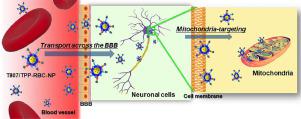当前位置:
X-MOL 学术
›
Acta Biomater.
›
论文详情
Our official English website, www.x-mol.net, welcomes your
feedback! (Note: you will need to create a separate account there.)
Neuronal mitochondria-targeted delivery of curcumin by biomimetic engineered nanosystems in Alzheimer's disease mice.
Acta Biomaterialia ( IF 9.4 ) Pub Date : 2020-04-03 , DOI: 10.1016/j.actbio.2020.03.029 Chunhong Gao 1 , Yuli Wang 1 , Jiejie Sun 1 , Yang Han 2 , Wei Gong 1 , Yi Li 1 , Ye Feng 1 , Hao Wang 1 , Meiyan Yang 1 , Zhiping Li 1 , Yang Yang 1 , Chunsheng Gao 1
Acta Biomaterialia ( IF 9.4 ) Pub Date : 2020-04-03 , DOI: 10.1016/j.actbio.2020.03.029 Chunhong Gao 1 , Yuli Wang 1 , Jiejie Sun 1 , Yang Han 2 , Wei Gong 1 , Yi Li 1 , Ye Feng 1 , Hao Wang 1 , Meiyan Yang 1 , Zhiping Li 1 , Yang Yang 1 , Chunsheng Gao 1
Affiliation

|
Biomimetic nanotechnology represents a promising approach for the delivery of therapeutic agents for the treatment of complex diseases. Recently, neuronal mitochondria have been proposed to serve as a promising therapeutic target for sporadic Alzheimer's disease (AD). However, the efficient intravenous delivery of therapeutic agents to neuronal mitochondria in the brain remains a major challenge due to the complicated physiological and pathological environment. Herein, we devised and tested a strategy for functional antioxidant delivery to neuronal mitochondria by loading antioxidants into red blood cell (RBC) membrane-camouflaged human serum albumin nanoparticles bearing T807 and triphenylphosphine (TPP) molecules attached to the RBC membrane surface (T807/TPP-RBC-NPs). With the advantage of the suitable physicochemical properties of the nanoparticles and the unique biological functions of the RBC membrane, the T807/TPP-RBC-NPs are stabilized and promote sustained drug release, providing improved biocompatibility and long-term circulation. Under the synergistic effects of T807 and TPP, T807/TPP-RBC-NPs can not only penetrate the blood-brain barrier (BBB) but also target nerve cells and further localize in the mitochondria. After encapsulating curcumin (CUR) as the model antioxidant, the research data demonstrated that CUR-loaded T807/TPP-RBC-NPs can relieve AD symptoms by mitigating mitochondrial oxidative stress and suppressing neuronal death both in vitro and in vivo. In conclusion, the intravenous neuronal mitochondria-targeted biomimetic engineered delivery nanosystems provides an effective drug delivery platform for brain diseases. STATEMENT OF SIGNIFICANCE: The efficient intravenous delivery of therapeutic agents to neuronal mitochondria in the brain remains a major challenge for drug delivery due to the complicated physiological and pathological environment. To address this need, various types of nanovessels have been fabricated using a variety of materials in the last few decades. However, problems with the synthetic materials still exist and even cause toxicology issues. New findings in nanomedicine are promoting the development of biomaterials. Herein, we designed a red blood cell (RBC) membrane-coated human serum albumin nanoparticle dual-modified with T807 and TPP (T807/TPP-RBC-NPs) to accomplish these objectives. After encapsulating curcumin as the model drug, the research data demonstrated that the intravenous neuronal mitochondria-targeted biomimetic engineered delivery nanosystems are a promising therapeutic candidate for mitochondrial dysfunction in Alzheimer's disease (AD).
中文翻译:

仿生工程纳米系统在阿尔茨海默氏病小鼠中神经元线粒体靶向姜黄素的递送。
仿生纳米技术代表了一种用于治疗复杂疾病的治疗剂的有前途的方法。最近,已经提出了神经元线粒体作为散发性阿尔茨海默氏病(AD)的有希望的治疗靶标。然而,由于复杂的生理和病理环境,将治疗剂有效地静脉内递送至脑中的神经元线粒体仍然是主要挑战。在本文中,我们设计并测试了将抗氧化剂加载到红细胞(RBC)膜伪装的人血清白蛋白纳米颗粒中的功能性抗氧化剂传递到神经元线粒体的策略,该人血清白蛋白纳米颗粒带有附着在RBC膜表面的T807和三苯膦(TPP)分子(T807 / TPP -RBC-NPs)。凭借纳米颗粒合适的理化特性和RBC膜独特的生物学功能,T807 / TPP-RBC-NP得以稳定并促进药物的持续释放,从而提供了改善的生物相容性和长期循环。在T807和TPP的协同作用下,T807 / TPP-RBC-NPs不仅可以穿透血脑屏障(BBB),而且可以靶向神经细胞并进一步定位于线粒体。在将姜黄素(CUR)封装为模型抗氧化剂后,研究数据表明,加载CUR的T807 / TPP-RBC-NPs可通过减轻线粒体的氧化应激并抑制体内外神经元死亡来缓解AD症状。结论,靶向神经元线粒体的仿生工程化递送纳米系统为脑部疾病提供了有效的药物递送平台。意义声明:由于复杂的生理和病理环境,将治疗剂有效地静脉内递送至脑中神经元线粒体仍然是药物递送的主要挑战。为了满足这种需求,在过去的几十年中,已经使用多种材料制造了各种类型的纳米容器。但是,合成材料仍然存在问题,甚至会引起毒理学问题。纳米医学的新发现正在促进生物材料的发展。在这里,我们设计了一个红细胞(RBC)膜包裹的人血清白蛋白纳米粒子,经T807和TPP(T807 / TPP-RBC-NPs)双重修饰,以实现这些目的。
更新日期:2020-04-03
中文翻译:

仿生工程纳米系统在阿尔茨海默氏病小鼠中神经元线粒体靶向姜黄素的递送。
仿生纳米技术代表了一种用于治疗复杂疾病的治疗剂的有前途的方法。最近,已经提出了神经元线粒体作为散发性阿尔茨海默氏病(AD)的有希望的治疗靶标。然而,由于复杂的生理和病理环境,将治疗剂有效地静脉内递送至脑中的神经元线粒体仍然是主要挑战。在本文中,我们设计并测试了将抗氧化剂加载到红细胞(RBC)膜伪装的人血清白蛋白纳米颗粒中的功能性抗氧化剂传递到神经元线粒体的策略,该人血清白蛋白纳米颗粒带有附着在RBC膜表面的T807和三苯膦(TPP)分子(T807 / TPP -RBC-NPs)。凭借纳米颗粒合适的理化特性和RBC膜独特的生物学功能,T807 / TPP-RBC-NP得以稳定并促进药物的持续释放,从而提供了改善的生物相容性和长期循环。在T807和TPP的协同作用下,T807 / TPP-RBC-NPs不仅可以穿透血脑屏障(BBB),而且可以靶向神经细胞并进一步定位于线粒体。在将姜黄素(CUR)封装为模型抗氧化剂后,研究数据表明,加载CUR的T807 / TPP-RBC-NPs可通过减轻线粒体的氧化应激并抑制体内外神经元死亡来缓解AD症状。结论,靶向神经元线粒体的仿生工程化递送纳米系统为脑部疾病提供了有效的药物递送平台。意义声明:由于复杂的生理和病理环境,将治疗剂有效地静脉内递送至脑中神经元线粒体仍然是药物递送的主要挑战。为了满足这种需求,在过去的几十年中,已经使用多种材料制造了各种类型的纳米容器。但是,合成材料仍然存在问题,甚至会引起毒理学问题。纳米医学的新发现正在促进生物材料的发展。在这里,我们设计了一个红细胞(RBC)膜包裹的人血清白蛋白纳米粒子,经T807和TPP(T807 / TPP-RBC-NPs)双重修饰,以实现这些目的。











































 京公网安备 11010802027423号
京公网安备 11010802027423号